Several people have complained that I no longer do full write-ups of our Casa S dinners, having opted for a scattering of more detailed, individual recipes of dishes that have been particularly successful. On the other hand, when I was doing full write-ups, roughly the same number of people (possibly the same people, now that I think about it) complained that it was boring to read through descriptions of each week’s dinners, particularly since a couple of years ago we stopped doing the, more or less, never repeat a dish routine. We actually never had a never repeat a dish routine, but there was definitely less repetition prior to settling on what has become our style of cooking with its Andean and Mediterranean combo-bent.
So, I’m not going to go back to a weekly write-up, but an occasional, shorter one, particularly where I don’t feel like I’ve honed down any one particular recipe to what will turn out to be its more final version, may be in order. Mostly, I’m going to stick with the plate-by-plate recipe approach, which is also helping codify the long awaited Casa S cookbook, which is now pretty much written other than filling in some of the recipes.
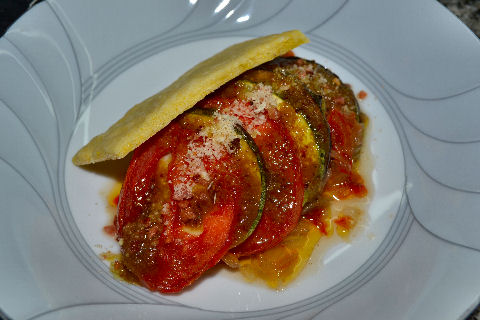
I realize that this is not nearly as pretty as the animated version of a confit bayaldi as was passed off as ratatouille in the film of the same name, but it’s my version. Alternating slices of eggplant, zucchini and tomato roasted in a covered tray over a bed of chopped bell pepper, onion and garlic; a polenta and romano cheese crisp on the side; several tablespoons of a spicy dressing of brown sugar, peperoncino, anchovy, pink peppercorn and smoked mustard, and a toasted crumble of panko crumbs and serrano ham.
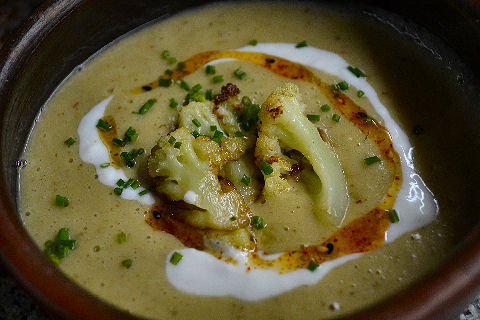
The one real repeat, our ever popular hummus soup with charred cauliflower, salted yogurt, and chili oil.
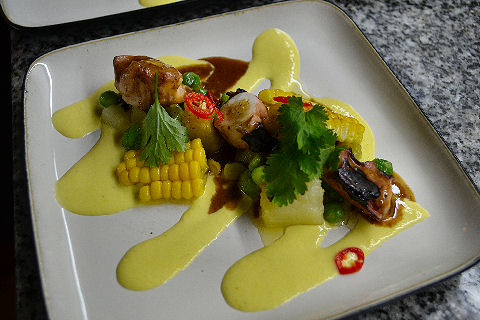
A completely new dish, inspired by one of the nigiri sushi that I tried at Osaka Puerto Madero last month. Here, jibia (Humboldt squid) tentacles pachamanca (braised in beer, beef stock, olive oil, red wine vinegar, cumin, cilantro, oregano, huacatay, garlic) for about an hour and a half until tender. Served over a corn puree, with a saute of yuca, sweet potato, peas, and corn “planks”; drizzled with a reduction of of the braising liquid finished with a little butter, and scattered with cilantro leaves and thin rounds of ají limo chilies.
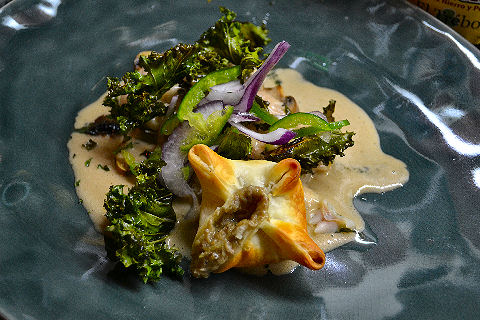
Quickly sauteed rubio (more properly rascacio rubio), a type of rockfish that we only get for a short period each year (tried the dish out with a type of shark one night, cazón, but wasn’t happy with the texture of the fish in the final plating). Served over a mushroom stock “ajillo“, or garlic sauce, and a bed of roasted mushrooms. Accompanied by a little puff pastry filled with spicy mushroom filling, roasted kale chips, and thin slices of red onion and rocoto chilies.

And, finished off the menu with a kumquat, cashew and brazil nut caramel tart; white chocolate and Hesperidina mousse; orange infused sugar syrup.
That should be enough to keep you for a short while, no?

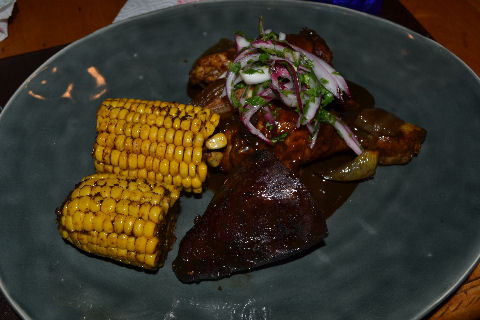
Oh, and just an additional note – because we only reduced enough of the pachamanca braising liquid to create a thickened sauce for the squid dish, we had a couple of liters of it leftover, and Sunday afternoon “dinner” was a pachamanca de pollo for ourselves and visitors – a whole chicken, cut up, braised in half the liquid, onions, corn and sweet potatoes in the other half, and a little “salad” topping of cilantro, red onion, and serrano chilies tossed with vinegar and salt to top the whole thing.
Seeing the “confit bayaldi”, I first thought “funny, reminds me of the Turkish imam bayildi”, and checking the Wikipedia link, I see that the name indeed comes from the Turkish dish. https://en.wikipedia.org/wiki/Confit_byaldi “Imam bayildi” literaly means “the imam fainted” by the way, but bayildi could also be used for being very fond of something. Fittingly, there are two stories about its name. Again quoting from Wikipekia: “The name supposedly derives from a tale of a Turkish imam, who swooned with pleasure at the flavor when presented with this dish by his wife, although other more humorous accounts suggest that he fainted upon hearing the cost of the ingredients or the amount of oil used to cook the dish.” The latter story is the more favoured one.
Yes, and great story! Confit bayaldi is definitely a derivative of iman bayaldi, which Larousse describes as, “A Turkish dish of stuffed eggplants whose name means ‘the iman fainted’. According to legend, when eggplants prepared this way were offered to a certain imam (priest), he was so moved the fragrant odor of the dish that he fainted from sheer gastronomical joy! The stuffing is made with a mixture of the eggplant pulp, onions, and tomato. Cooked rice is sometimes added, together with various spices, and aromatic herbs, but not meat. The dish may be served hot or cold. In classic [I assume, being Larousse, classic = French] cuisine, the garnish à l’imam bayildi consists of slices of fried eggplant, sauteed halved tomatoes, and pilaf rice; it is served with tournedo steaks or noisettes of lamb.”
The history of confit bayaldi only goes back to the 70s, it was a Michel Gerard “invention” for his 1976 recipe book Cuisine Minceur, a way of lightening up classic French dishes. Ratatouille classically involving frying the vegetables in a fair amount of oil. In his version, inspired by the baked dish of imam bayaldi (though he doesn’t acknowledge it in his cookbook, he apparently did in various interviews on the subject), he lines up slices of alternating zucchini, eggplant, tomatoes, mushrooms and onions, dresses them in olive oil, thyme and garlic, and bakes the dish under foil to steam it in the oven, then removes the foil and cooks it down to the point the vegetables become “like a vegetable marmalade”. Thomas Keller, years later (his 1999 The French Laundry Cookbook), ran with the idea, and came up with the beautiful presentation version of roasted vegetables that we all came to admire in its animated form in the movie Ratatouille, taking out the mushrooms and adding in yellow summer squash.
I thought it might be interesting to see the “evolution” (all photos lifted from one or another sites on the internet as illustrative, and with apologies for my appropriation of them):
A fairly classic ratatouille.
A fairly classic, elegantly presented imam bayaldi
Michel Gerard’s version of confit bayaldi from 1976
Thomas Keller’s version of confit bayladi from The French Laundry
And, the re-creation of it for the movie Ratatouille
Thank you for the post Dan! 🙂 Confit bayildi sounds like a very good idea by the way, especially because the ingredients are not fried. Will try! Though I like the filling of imam bayildi, that fried eggplant bit of it is really not for me. Unfortunately fried eggplant is very much loved in Turkish cuisine and it shows up in a variety of dishes. Luckily more and more people give up the habit of frying it. Imam bayildi as well as its meat filled version, karniyarik (meaning “slashed belly”, not a very appetizing name but definitely accurate) can both be made with oven roasted eggplant and that is much better, also because of the slightly smoky taste it gets from the roasting.